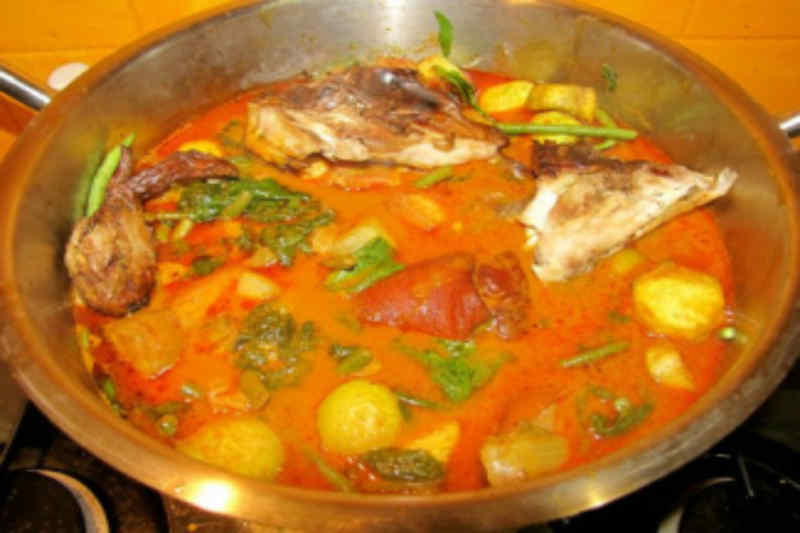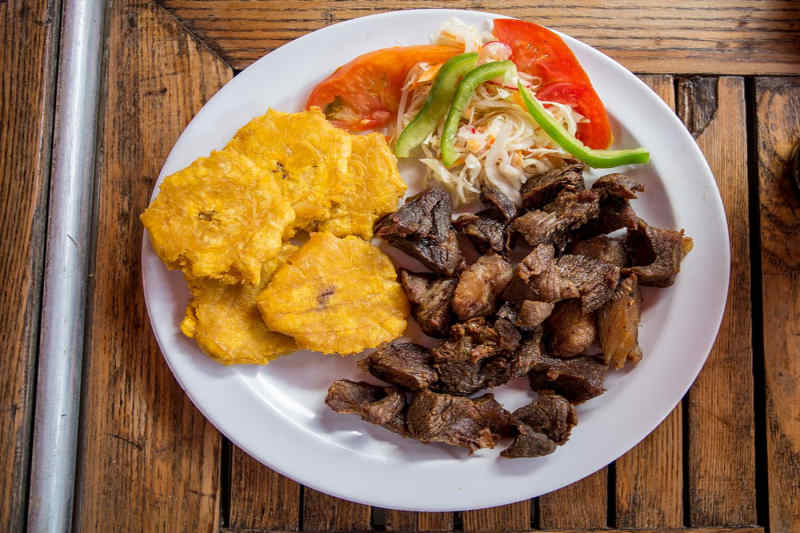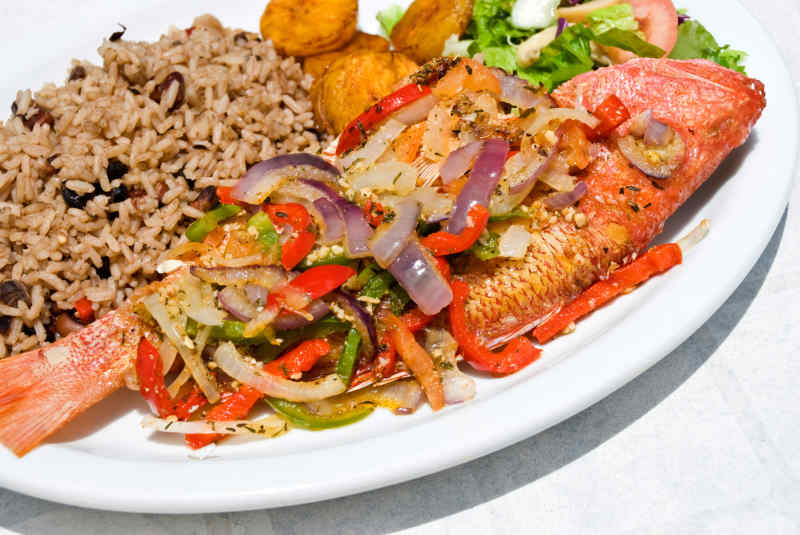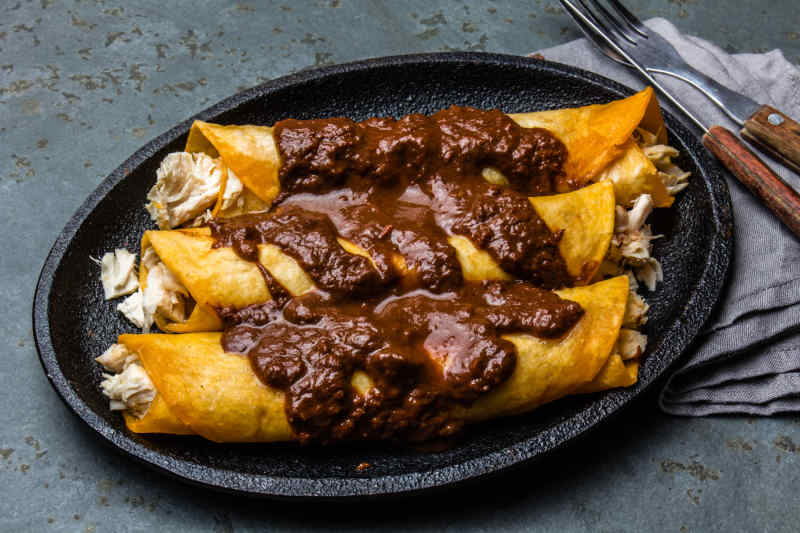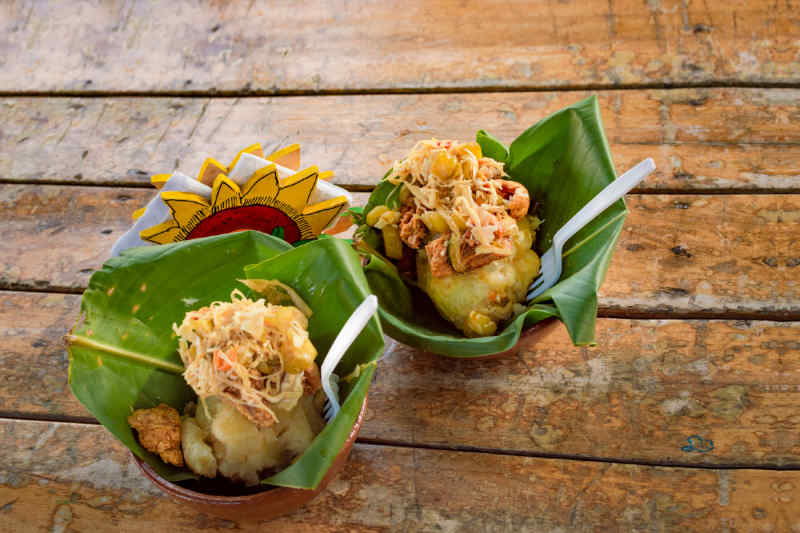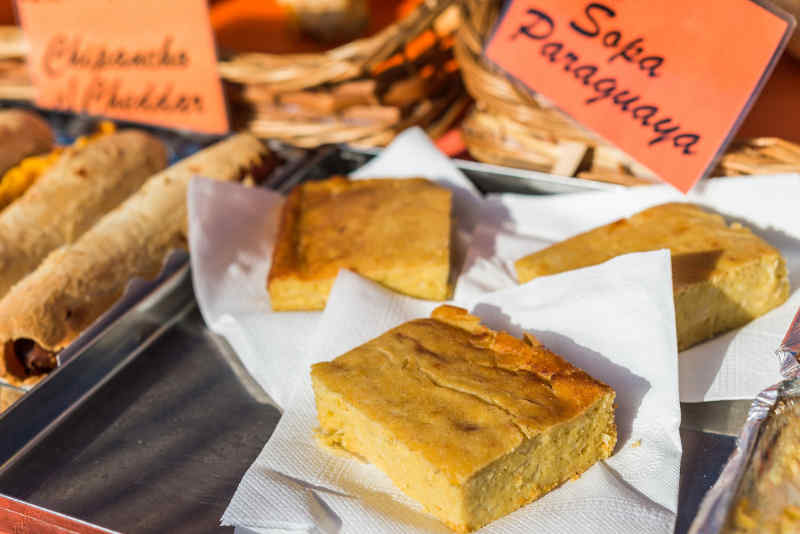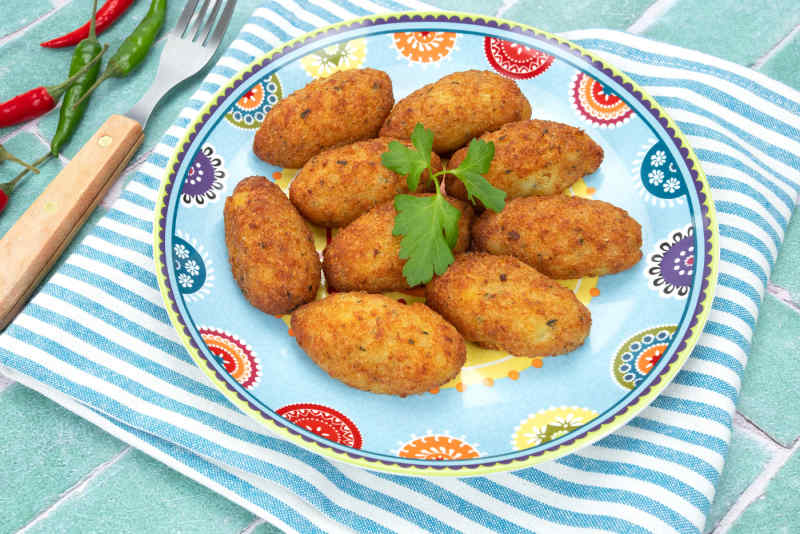By Soren Rivero
Hispanic Heritage Month is a thirty-day celebration in the United States commemorating the cultural influences of Spain, Mexico, South America, Central America, and parts of the Caribbean. One way to celebrate and honor Hispanic and Latin communities is by learning about and tasting some of their most cherished foods!
This article will cover one dish from every Hispanic or Latin country as well as some information about each country’s cuisine. Celebrate the Hispanic and Latin communities by trying these dishes, not only during Hispanic Heritage Month, but all year-long!
Click a country to jump to that section of the list: Argentina, Bolivia, Brazil, Chile, Colombia, Costa Rica, Cuba, Dominican Republic, Ecuador, El Salvador, Equatorial Guinea, French Guiana, Guadeloupe, Guatemala, Haiti, Honduras, Martinique, Mexico, Nicaragua, Panama, Paraguay, Peru, Puerto Rico, Spain, St Barthelemy, St Martin, Uruguay, Venezuela
Argentina
Asado
Argentina’s national dish is asado. Interestingly, Argentines know ‘asado’ not as a dish but rather as an event. During an asado, an asador lights a fire over a parilla (grill) while others gather around to enjoy appetizers and prepare other side dishes. The actual ‘dish’ part is the meat, which is a combination of beef, lamb, pork, and chicken that are all cooked slowly and only seasoned with salt. Asado is a dish that’s been adopted by other South American countries, though Argentina has made the cooking method synonymous with the dish. Asados are often accompanied by good music and plenty of quality time with family and friends.
Bolivia
Salteñas
Known for its dangerous roads that tread through jungles, high altitudes, and llamas, Bolivia is a country with an interesting terrain. Some of the most important crops are corn, potatoes, quinoa and other grains, and cocoa. You’ll find some of these introduced into the country’s popular foods, such as the national dish known as Salteñas. These hand-sized delights are in the shape of a football and come stuffed with vegetables, beef or chicken, olives, raisins, hard boiled eggs, and tons of spices.
Brazil
Feijoada
Brazil’s gastronomy is influenced by the country’s Indigenous people, parts of Europe, India, and even Japan. But the basis of the cuisine is mostly a mix of Indigenous, Portuguese, and Indian Cuisine. Thus, some staples of the cuisine are rice, beans, bread, and meat. The country’s most famous dish, Feijoada, is no exception. Feijoada is made from black beans cooked in vegetables and different cuts of meat. Also added in is offal (organs of butchered animals). The dish is served with rice, fried kale, cassava toast, and oranges.
Chile
Pastel de Choclo
Despite the country sharing its name with the hot pepper, Chilean food is not actually all that spicy. The cuisine in this mountainous country has roots in Indigenous cultures as well as Spain, Germany, and France. Many of the dishes are quite simple, using meat, vegetables, and flour as basic ingredients. If there’s one food from Chile you must try though– it’s pastel de choclo. This one pot dish is made from a cousin of the corn plant called choclo. Pureed choclo is mixed in with ground beef, spices, chicken, hard-boiled eggs, and black olives. The dish is typically made in a clay pot and topped with a light sprinkle of sugar for a crunch coat.
Colombia
Bandeja Paisa
Colombian cuisine has roots in Indigenous and Spanish influences with some unique inspiration from African and Arab countries. As you can see, there’s quite a bit going on when it comes to Colombia. Thus, the large and complex Bandeja Paisa is the perfect fit for Colombia’s national dish. Included in this large platter (bandeja) are beans, rice, chorizo, chicharrón, a fried egg, avocado, hogao, platanos fritos(fried plantains), and arepa.
Costa Rica
Gallo Pinto
If you’ve read this list up to now and haven’t seen any vegan-friendly dishes– you’re in luck! Costa Rica has plenty of options in their cuisine that don’t include meat. Some of the staples of Costa Rican cuisine are rice, beans, and potatoes– you’ll find them in almost every meal. The cuisine also stays true to its roots as it is heavily inspired by the food of the Indigenous people. Given its geographical position, Costa Rica is also known as the cultural bridge between North America and South America. The most famous dish is Gallo Pinto. Simply put, this dish is leftover rice mixed with beans, onions, cilantro, red pepper, and topped with salsa. Ticos (what Costa Ricans refer themselves to) eat this at any time of the day, but particularly at breakfast.
Cuba
Ropa Vieja
Cuba’s native population, the Taíno people, ate mostly fruit, manioc, fish, and potatoes. Between the events of Spanish colonization, the African Slave Trade, the Soviet War, and the United States occupying the island, the country’s gastronomy has shifted quite drastically. The cuisine in Cuba is mostly Spanish inspired. If there’s one Cuban food you must try, it’s Ropa Vieja (translation: old clothes). Ropa Vieja is a derivative of the Spanish dish but with Cuban interpretation. It's made from shredded flanks, onions, and bell pepper in sauce and served with rice and plantains.
Dominican Republic
La Bandera Dominicana
Dominican cuisine is very similar to other parts of the Caribbean as well as countries that have Spanish influence. The most popular (and national) dish in the Dominican Republic is more reflective of the country’s Indigenous and Spanish roots. La Bandera Dominicana translates to “the Dominican Flag”. Similar to Colombia, this dish is large and will surely fill your belly. The base of La Bandera Dominicana is rice, beans, and meat. Other food items are added to complete the meal. These include tostones, avocados, eggplant, and salad.
Ecuador
Bolon de Verde
Fruit lovers will especially love the cuisine of Ecuador. Plenty of unique fruits are grown and enjoyed by locals on the island, some of which you’ve probably never heard of (cocona, borojo, chonta). If you want to get a taste of local Ecuador– sample some of the fruit native to the country! Otherwise, you’ll enjoy the country’s national dish of Bolon de Verde. These little round morsels are made from green plantains then stuffed with meat and cheese. For the most authentic experience, eat some of these with hot sauce and a cup of coffee.
El Salvador
Pupusas
Many of the dishes in Salvadorian cuisine are made from maize(corn). Though El Salvador’s cuisine has seen some shifts from other cultural influences, the cuisine is still widely composed of foods eaten by the Indigenous people. Some notable foods include corn tortillas, empanadas, atol (corn drink), and elote loco. But by far the most recognized Salvadorian dish is pupusas. These flat, meat and cheese filled delights are almost as common as finding tacos in other parts of the world. Feel free to order as many as you can handle– just don’t forget to add plenty of red tomato sauce and curtido (cabbage relish)!
Equatorial Guinea
Bambucha
Equatorial Guinea is a little bit different from the other countries listed here so far, mainly because it’s the only Hispanic country on the African Continent. The country’s dominant ethnic group are the native Fang people. Coming in second place are other Bantu tribes. Each of these groups of people have their own native language, yet the “official” languages of Equatorial Guinea are Spanish and French. If you are unfamiliar with Equatorial Guinea’s history with Spain, you can brush up on it here. The country is now independent from Spanish control. Similar to that, the food of Equatorial Guinea is more closely related to other African countries. Bambucha is a food most commonly eaten by the Fang ethnic group, though it is now very popular across the entire country. This dish is a simple mix of cassava leaves and palm oil and is eaten alongside taro and cassava.
French Guiana
Bouillon D'awara
French Guiana is an overseas territory of France located on the northern tip of South America. French is the official language. Because of this as well as the fact that the country has similar influences to other countries in South America, French Guiana is considered to be Latin American. That being said, their culture and food differ quite a bit from other countries on this list as they have little to no Spanish influence. Their national dish is bouillon d'awara, a stew made from smoked fish, shrimp, crab, chicken, and vegetables. These ingredients are then combined with the pulp of the Awara fruit and served alongside rice. Try this beloved dish from French Guiana that many natives claim to be their favorite comfort food!
Guadeloupe
Bokit
Guadeloupe is another overseas territory of France located in the Caribbean. One of the most notable things about the island is that it physically resembles a butterfly. The island’s cuisine is an adaptation of a few different cultures similar to other islands along the Caribbean. If you get a chance to try any food from Guadeloupe, make sure to include bokits. These sandwich-like meals are not only delicious, but a representation of the island’s complex history with colonization and slavery. It starts with a pillowy-fried dough stuffed with a choice of over ten ingredients. Try yours with vegetables, various meats, curry, cheeses, sauces, seafood, and much else!
Guatemala
Pepián de Pollo
Guatemala is a Central American country iconic for its massive volcanoes, lush rainforests, and ancient Mayan architecture. To add onto that, a considerable amount of the largest and most complex Mayan ruins across the Americas are located in Guatemala. The country’s cuisine is consistent with Mayan influence. The most beloved dish in Guatemala, Pepián de Pollo, is a fusion of Mayan and Spanish cuisine. This stew is an eruption of spicy flavor, very representative of the country’s volcanoes. It starts with a soup made from onions, vegetables, chiles, and a handful of spices. The stew gets its name from the pepitas (pumpkin seeds) which not only thicken the base, but give it a very nice nutty flavor. Afterwards, chicken and more vegetables are added then served alongside rice and corn tortillas.
Haiti
Griyo
The country of Haiti is located on the island of Hispaniola (sharing it with the Dominican Republic), with their two official languages being French and Creole. The country was first inhabited by the Taíno people, then colonized by Christopher Colombus in the late fifteenth century. African slaves were brought to the island by both the Spanish Empire and the Kingdom of France. Between all these groups of people merging together, the food has become quite diverse. The country’s national dish is Griyo– baked pork shoulder marinated in Haitian herbs, citrus juice, vegetables, and spices. It is then served along with fried plantains and rice.
Honduras
Baleadas
Honduran gastronomy has to be one of the most diverse out of all the Hispanic countries. It takes influence from Indigenous, pre-Columbian, African, Creole and Caribbean cultures. You’ll find a wide range of elements used within Honduran cooking. Fish, meat, fruit, vegetables, grains, dairy products, and much else are very common in Honduran cuisine. To celebrate the wide range of food options, try out some baleadas. These staple Honduran foods are made by packing together refried beans, cheese, crema, inside a large flour tortilla. The options don’t stop there, though. Feel free to add vegetables, meat, seafood, butter, eggs, avocado, and much more to your baleadas.
Martinique
Grilled Snapper
Being centered right in the middle of the lesser antilles, Martinique is bound to have some heavy Caribbean notes in their cuisine. Though, the country’s connection to Europe means that it will also see influence from those cultures– especially France. The country’s favorite dish of grilled snapper with creole sauce is a perfect representation of that. One bite of this national dish and you’ll get a taste of seaside goodness with a local twist.
Mexico
Mole
Many people’s image of Mexican cuisine has been drastically blurred by the influx of “Mexican” style restaurants now popular throughout the entire world. These often focus on tacos, enchiladas, burritos, and quesadillas. Although these are staples in Mexico, it erases the roots of Native Americans in favor of ‘taste-friendly’ foods. To get the most authentic taste of Mexico, you’ll want to grab a bite of Mole. This isn’t exactly a ‘dish’ itself as it is more of a sauce. The word is derived from the Nahuatl language of the Aztecs “mōlli” which means concoction or sauce. Mole is quite diverse, as it can be made with either chiles, nuts, seeds, and even chocolate. Mole is served over proteins (meat or tofu), vegetables, tacos, enchiladas, and more. Dozens of different versions of mole exist that usually appear in different regions and on popular holidays (such as Día de Muertos).
Nicaragua
Vigorón
It’s no surprise that Nicaruagua being right next to Costa Rica would mean that the two countries share similar foods and cooking methods. Just like Costa Rica, the most popular dish in Nicaragua is gallo pinto. To create some variety, we’ll be sharing another popular food that many Nicaraguans love. Vigorón is a dish that hails from the city of Granada in Nicaragua. The inventor of this well-balanced meal is María Luisa Cisneros who named it after an advertised tonic with the similar name. Cassava is mixed with chicharrón (pork rinds) and placed on a chagüite leaf. The dish is finished with a topping of cabbage salad and mimbro.
Panama
Sancocho
We’ve now arrived at the isthmus country that links together Central and South America. Panama’s geographical location has played a major role in events related to Spain, Gran Colombia, and the United States via the Panama Canal. As it often shifted between joining other forces and being independent, Panama’s gastronomy and culture has seen big changes. Panamanian cuisine is one of the more difficult to pin down because of all the influences it has received. Still, Sancocho is at the top of the most beloved dishes in Panama and is eaten for breakfast, lunch, and dinner. Chicken, broth, vegetables, and rice are put together in a heartwarming soup that’s made all the better by the abundant use of culantro.
Paraguay
Sopa Paraguaya
Paraguay is one of the only countries in the Latin and Hispanic worlds that still use their people’s native language as a primary form of communication. Both Spanish and the native language of Guaraní are official languages in Paraguay. Most people can speak both! And just like the language, the cuisine in Paraguay is a decent blend of both Spanish and Native foods. The most famous dish would be Sopa Paraguaya. Despite it having ‘sopa’ in the name (soup in spanish), it is a solid food similar to cornbread. The unique taste comes from the mix of cornmeal, eggs, butter (or lard), milk, cheese, and onions.
Peru
Ceviche
Home to the legendary Incan fortress known as Machu Picchu, Perú is a fascinating country with so much to offer. You’ll find anything from ancient Nazca Lines, unique fruit, huge jungles, and over 13 native languages spoken. Peruvian food is just as fascinating and has even been ranked over and over again as one of the best foodie countries in the world. Perú is even thought to be the gourmet capital of South America! The country’s national dish of Ceviche is a true symbol of how exquisite the food in Perú can be. Other countries have adopted their own version of ceviche but Perú’s version started off with a simple mix of just a handful of ingredients. Included is marinated fresh fish (usually sea bass), onions, corn, and sweet potatoes.
Puerto Rico
Arroz con Gandules
The island country of Puerto Rico is a commonwealth of the United States. The people of Puerto Rico are proud and more often than not function as an independent nation in events such as the Olympics and Miss Universe pageants. The island’s national dish stands proud by itself while taking some influence from other Caribbean cuisines. Arroz con gandules is a one-pot mixture of rice, pigeon peas, and pork cooked together with sofrito (sauce).
Spain
Paella
Tracing many of these countries back to their roots will land you back in Spain, the European country along the Iberian peninsula. Spanish influence has forever changed the world in many ways. Language is one of those ways, and is a primary thing that binds together all the Hispanic countries into one category. The country’s national dish of paella is loved by communities all over the peninsula– and just like the language, all over the world. Paella is a comfort food made from rice and saffron then mixed with various meats and vegetables. The most famous version is likely paella de marisco, which uses loads of different fish and shellfish for a unique taste.
St Barthelemy
Accras
The island country of St. Barthélemy is located just under the Barthélemy Channel along the Leeward Islands. Also known as St. Barts, the island is a French-speaking Caribbean island with diverse influences. Almost a hundred different restaurants featuring different cuisines from around the world in its capital city of Gustavia. To get a taste of authentic St. Barts, try accras. These handheld savory bites are made from salt-dried fish that’s been breaded and fried. They’re typically served with a spicy creole sauce.
St Martin
Callaloo
St. Martin is an island country in the Caribbean that shares land with St. Marteen. The two countries are along the Leeward Islands. St. Martin is the northern half of the island and a French speaking country. Most of the food you’ll find in this country are a fusion of Caribbean, Indian, and French cuisine. One of the national dishes in this country is called callaloo– a thick soup made with pork, onions, okra, peppers, and the callaloo plant (similar to spinach).
Uruguay
Chivito
Despite Uruguay being the smallest Spanish speaking country in South America, it boasts a number of interesting records. In terms of food, Uruguay consumes the most mate (an infused tea beverage containing caffeine), as well as beef in all of South America. Staying true to their love of beef, the national food of Uruguay is the chivito. It starts off with a thin slice of beefsteak topped with melted cheese, ham, tomatoes, olives, pickles, and onions. All of the ingredients are then stuffed between toasted bread then served with a side of french fries. Chivito translates to ‘baby goat meat’ as the sandwich originally used goat meat instead.
Venezuela
Pabellón Criollo
Did you know that the full official title of Venezuela is “The Bolivarian Republic of Venezuela?” Though this was a recent change, not much is known about Venezuela to the world. One way to honor Venezuela is by trying out some of their food. Finding a good Venezuelan spot in the U.S. can be a challenge to some, but with the right amount of luck, you’ll find what you’re searching for. One Venezuelan meal you can’t miss out on is Pabellón Criollo. This dish represents the three cultures that have forever shaped Venezuela’s community. Black beans, pulled pork, and white race resemble the country’s Indigenous, African, and European influences.
Try out some of these cherished foods from Hispanic and/or Latin communities whenever you get the chance! Interested in visiting one or more of the countries listed here? Check out our vacation packages below.












